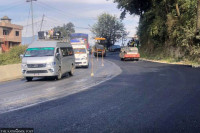National
Kathmandu metropolis to monitor the city’s air quality on its own
It has received 17 portable air quality monitoring sensors, which are being calibrated with ground stations operating in the Capital.
Post Report
The Environment Department under the Kathmandu Metropolitan City is preparing to start monitoring the city's air quality on its own, with support from the Partnership for Healthy Cities, which has provided portable devices to the city office to monitor air quality.
The Partnership for Healthy Cities is a global network of 74 cities, including the Kathmandu metropolis, committed to saving lives by preventing noncommunicable diseases and injuries. The programme is supported by Bloomberg Philanthropies in partnership with the World Health Organisation and Vital Strategies.
“We have got 17 air quality sensors, which are portable and can be set up at any location,” said Rabinman Shrestha, chief of the Environment Department under the city office. “Those sensors are being calibrated with ground stations for air quality monitoring installed by various agencies to reduce errors.”
Nepal’s air quality reaches hazardous levels several times a year, and the capital city often becomes the world’s most polluted metropolis. Major hospitals report a spike in respiratory problems due to the impact of toxic air and dust. Doctors say even if cases of respiratory illnesses surge during winter and as the season changes across the world, in Nepal, people get sick throughout the year due to polluted air.
Metropolitan officials claim that air quality sensors, which are also called low-cost sensors, are widely acknowledged for bringing about a paradigm shift in supplemental traditional air monitoring.
“We hope that these sensors will help us in monitoring the air quality, take decisions on mitigation measures and formulate policies,” said Shrestha.
Once the sensors come into operation, the KMC will be the first local unit in the country monitoring air quality on its own.
“Air quality sensors do not need electricity, as they will be equipped with solar panels, and also do not need wifi,” said Engineer Sanjeeb Pandey, project lead of Partnership for Healthy Cities. “These sensors will provide real time data of air quality.”
Doctors say air pollution is known to cause various respiratory illnesses. Poor air quality can cause short- and long-term effects on public health. In the short term, it can lead to pneumonia, bronchitis, conjunctivitis, skin allergy, stroke, and heart problems, and in the long run it can lead to severe conditions like ulcers, and cancer of the lungs and intestine, kidney disease, and heart complications.
People in low- and middle-income countries get disproportionately affected by the polluted air, which accounts for more than 90 percent of deaths, according to the World Health Organisation.
Several studies carried out in the past in Nepal show that toxic air takes a huge toll on public health. Along with respiratory illness, the toxic air has led to severe conditions like ulcers, cancer of the lungs and intestine, kidney disease, heart complications, high blood pressure and stroke, according to experts.
The report, titled “Global burden and strength of evidence for 88 risk factors in 204 countries and 811 subnational locations, 1990–2021: A systematic analysis for the global burden of disease study 2021,” finds that air pollution was the leading contributor to the global disease burden in 2021, making for eight percent of total disability-adjusted life years (DALYs), followed by high blood pressure (7.8 percent). The report was published in The Lancet, a leading international medical journal.
Studies carried out in the past show that polluted air has been shortening people’s lives. Nepali lives are being cut short by around five years, according to a report by the Air Quality Life Index (AQLI), which converts air pollution concentration into an impact on life expectancy. AQLI is a metric produced by the Energy Policy Institute at the University of Chicago.
Toxic air is deadlier than tobacco use and high blood pressure, which reduce life by 2.8 years and 1.7 years, respectively, according to the report.
Environment experts in Nepal often point out that worsening air quality has not only affected people’s health but also hit the economy and hindered overall development of the country.




 16.57°C Kathmandu
16.57°C Kathmandu








%20(1).jpg&w=300&height=200)





